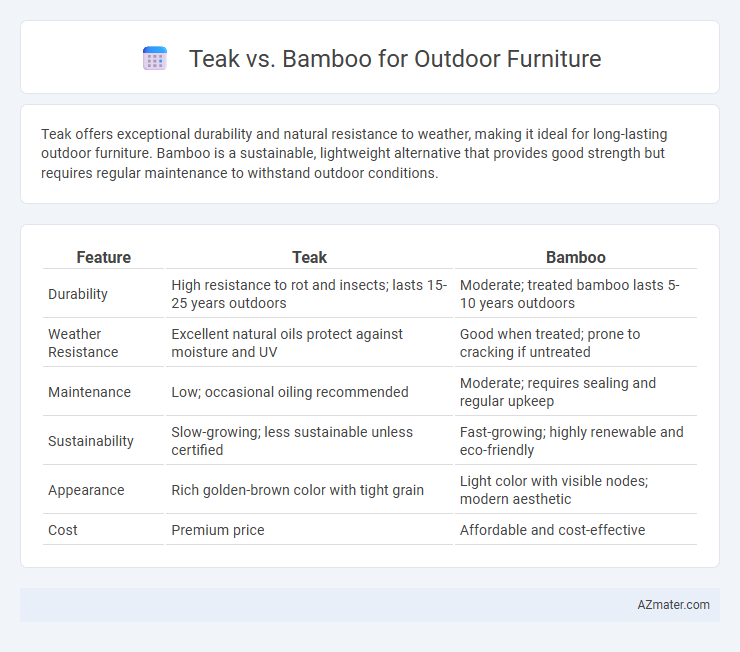Teak offers exceptional durability and natural resistance to weather, making it ideal for long-lasting outdoor furniture. Bamboo is a sustainable, lightweight alternative that provides good strength but requires regular maintenance to withstand outdoor conditions.
Table of Comparison
| Feature | Teak | Bamboo |
|---|---|---|
| Durability | High resistance to rot and insects; lasts 15-25 years outdoors | Moderate; treated bamboo lasts 5-10 years outdoors |
| Weather Resistance | Excellent natural oils protect against moisture and UV | Good when treated; prone to cracking if untreated |
| Maintenance | Low; occasional oiling recommended | Moderate; requires sealing and regular upkeep |
| Sustainability | Slow-growing; less sustainable unless certified | Fast-growing; highly renewable and eco-friendly |
| Appearance | Rich golden-brown color with tight grain | Light color with visible nodes; modern aesthetic |
| Cost | Premium price | Affordable and cost-effective |
Introduction: Teak vs Bamboo for Outdoor Furniture
Teak and bamboo are popular choices for outdoor furniture, each offering distinct advantages in durability and aesthetics. Teak wood is renowned for its natural oils that resist weathering, decay, and insect damage, making it highly durable for outdoor use. Bamboo provides a sustainable, lightweight alternative with rapid growth cycles, but often requires treatment to enhance its weather resistance and longevity.
Material Origins and Sustainability
Teak wood, harvested primarily from Southeast Asia, is prized for its natural oils and dense grain that provide exceptional durability and resistance to weathering in outdoor furniture. Bamboo, a rapidly renewable grass native to Asia, offers a sustainable alternative due to its fast growth rate and ability to sequester carbon efficiently. Both materials present eco-friendly options, but bamboo's shorter harvest cycle and minimal environmental impact make it a leading choice for sustainable outdoor furniture production.
Durability and Weather Resistance
Teak exhibits exceptional durability and weather resistance due to its high natural oil content, which protects it from moisture, insects, and decay, making it ideal for prolonged outdoor use. Bamboo, while eco-friendly and fast-growing, generally requires treatment and sealing to enhance its resistance to moisture and UV rays, as untreated bamboo is prone to cracking and warping in outdoor conditions. For long-lasting outdoor furniture, teak outperforms bamboo by maintaining structural integrity and aesthetic appeal under harsh weather elements.
Maintenance Requirements
Teak outdoor furniture demands regular maintenance, including periodic oiling to preserve its natural oils and prevent drying or cracking, ensuring long-term durability. Bamboo furniture, while more eco-friendly and lightweight, requires consistent sealing and protection from moisture to avoid warping, mold, and insect damage. Both materials benefit from routine cleaning and sheltering during extreme weather to extend their lifespan and maintain aesthetic appeal.
Aesthetic Appeal and Design Options
Teak offers a rich, warm color palette with natural grain patterns that enhance the classic and elegant look of outdoor furniture, while bamboo provides a lighter, more contemporary aesthetic with its smooth texture and variegated shades. Teak's design versatility allows for intricate carvings and robust, traditional styles, whereas bamboo supports minimalist, eco-friendly designs often favored in modern and tropical settings. Both materials complement outdoor environments beautifully, but teak's timeless appeal contrasts with bamboo's sustainable, trendy appeal.
Environmental Impact and Eco-Friendliness
Teak wood, known for its durability and natural resistance to weather, is sustainably harvested in certified plantations, but its slow growth rate raises concerns about deforestation. Bamboo, a rapidly renewable resource, absorbs carbon dioxide quickly and regenerates without replanting, making it a highly eco-friendly material for outdoor furniture. The environmental impact of bamboo products is generally lower than teak due to faster growth cycles and less intensive harvesting practices.
Cost Comparison and Value
Teak outdoor furniture typically commands a higher price due to its dense grain, natural oils, and durability against weather elements, making it a long-term investment with excellent value retention. Bamboo furniture offers a cost-effective alternative, providing a lightweight and eco-friendly option, though it may require more maintenance and has a shorter lifespan in harsh outdoor conditions. When comparing cost versus value, teak stands out for its longevity and minimal upkeep, while bamboo suits budget-conscious buyers seeking sustainable style with moderate durability.
Comfort and Practical Usage
Teak outdoor furniture offers superior comfort due to its natural resistance to moisture and smooth texture, making it ideal for prolonged seating without discomfort. Bamboo furniture combines lightweight design with durability, allowing easy mobility and quick drying during wet conditions, enhancing practical usability. Both materials excel in weather resistance, but teak's dense grain provides better long-term stability, while bamboo delivers eco-friendly flexibility and affordability.
Longevity and Performance Over Time
Teak outdoor furniture boasts exceptional longevity due to its dense hardwood structure and natural oils that resist rot, insects, and weather damage, often lasting 20-25 years or more with minimal maintenance. Bamboo furniture, while eco-friendly and lightweight, tends to have a shorter lifespan of 5-10 years outdoors as it is more susceptible to moisture, mold, and UV degradation unless specially treated. Over time, teak maintains its structural integrity and aesthetic appeal better than bamboo, making it a superior long-term investment for outdoor furniture.
Final Verdict: Which is Better for Outdoor Furniture?
Teak's natural oils and dense grain provide superior resistance to weather, insects, and decay, making it one of the most durable options for outdoor furniture. Bamboo is eco-friendly and lightweight, but requires regular treatment to withstand moisture and UV exposure over time. For long-lasting outdoor furniture with minimal maintenance, teak is the preferred choice due to its proven longevity and strength in diverse climates.

Infographic: Teak vs Bamboo for Outdoor Furniture
 azmater.com
azmater.com